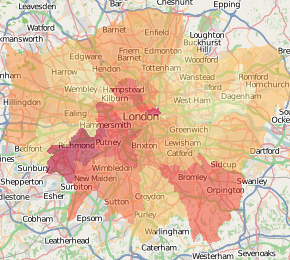
I’ve created a visualisation of how the TFL Cycle Hire scheme in London is being used – the so-called “Boris Bikes”. Around 4000 bikes have been placed in 400 cycle parking stands in the centre of the city, and people have been using them to get from A-B.
Some distinctive if not entirely surprising patterns have appeared already – with heavy usage (~10% of total bikes out on the streets) during the rush-hours, which occur in a strikingly small time interval – a narrow, sharp dip appearing only between 5:30pm to 6pm. Usage is much less in rainy weather, such as has happened today, and weekend use is both lower, and quite different in “shape”. During weekday days, the City tends to have a lot of the bikes, while in the evening, the bikes end up at the cycle parking stands near the big terminal train stations and in Pimlico in the south-west of the area – probably the biggest residential area covered by the scheme, and also a popular place for city workers to live…

10am Tuesday: Straight after a sunny morning rush-hour, before redistribution kicks in – many of the central stands are now completely full of bikes (red with yellow borders.)

8pm Tuesday: A typical evening pattern – the bikes are on the edge, and at the terminal stations, particularly around Waterloo and King’s Cross, while the centre is short of bikes…
The visualisation consists of coloured dots, which change from blue to red as each stand fills up with docked bikes. A purple dot indicates a half-full stand. The size of the dots corresponds to the total capacity of the stand.
You can click on a stand’s dot to see information about its current status, as well as its use over the last 24 hours, represented as a minimalistic graph. A graph of overall usage can also be viewed. Both get updated as the new data comes in.
The data comes from TFL’s own map of the stands in central London, and is updated at source typically every six minutes – my own visualisation updates every two minutes, so you should never be more than ten minutes out of date, looking at the map.
The background is a bespoke render of central London, from OpenStreetMap data.
See it here.
Here’s how the total number of available bikes has fluctuated, since Friday morning (click for larger version):

[Update: Some articles about the visualisation – Telegraph, Londonist, Road.cc, Real Cycling, Bikeradar]















